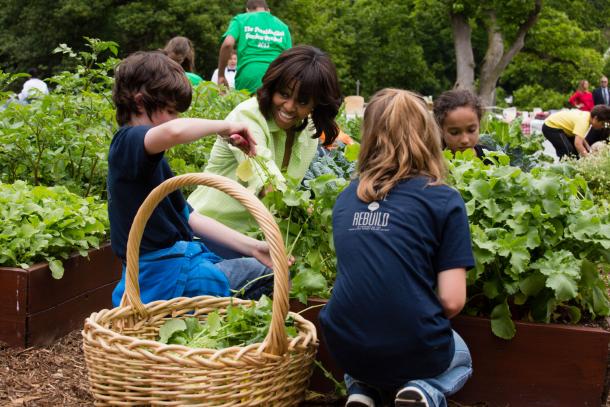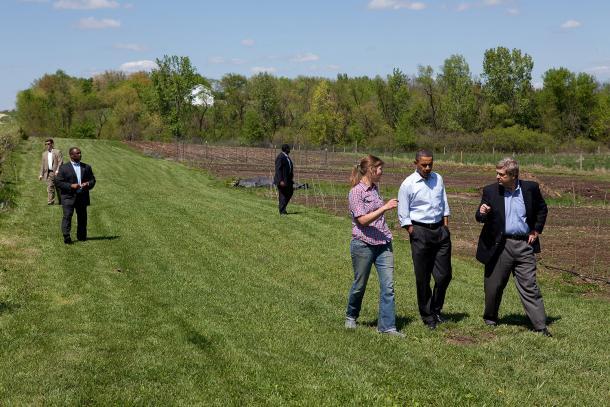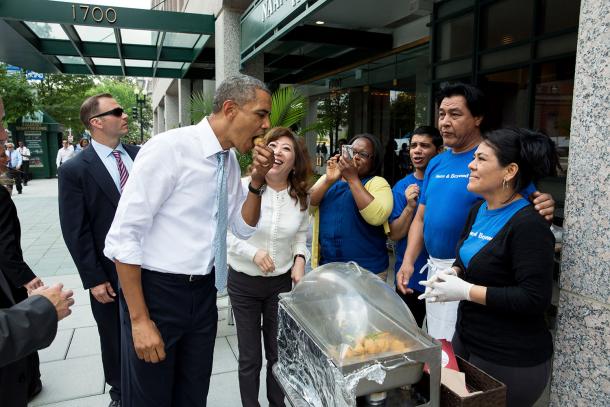Remembering the Obamas’ Food Legacy
Brie Mazurek, CUESA Staff
January 20, 2017

It may not have been perfect, but over the last eight years, the Obama Administration took significant strides to promote local and healthy food, both in policy and practice. Riding the wave of public interest piqued by exposés like The Omnivore’s Dilemma and Food Inc., President Obama and the First Lady did more to further the causes of local agriculture, children’s health, and food safety than any administration of our generation.
And what other presidential family has kept bees at the White House, homebrewed, eaten bun cha with Anthony Bourdain, and made turnips go viral?
Some critics argue that the Obama Administration didn’t do enough, that it failed to take on Big Food, didn’t curb the use of antibiotics, and conceded on GMO labeling. Still, the First Couple helped put local food on the national map and passed groundbreaking public health legislation in the face of fierce opposition from a formidable food industry lobby.
We have yet to see how these policies will weather the Trump administration, given the new president’s cabinet picks and taste for fast food. The incoming team seems determined to undo Obama’s legacy and roll back the last eight years of progress.
As we say farewell to the most food-forward administration in modern memory, here are a few of the Obamas’ major food milestones worth celebrating.
White House Vegetable Garden. Planted in 2009, Michelle Obama’s vegetable garden supplied hyperlocal veggies for the White House kitchen and a nearby soup kitchen, served as an educational resource for children, and was a powerful symbol of the First Lady’s priorities. The garden’s showcase of organic methods rankled big agriculture and pesticide companies, who saw the focus on sustainability as an affront to conventional methods. Last fall, Michelle took steps to (literally) cement her garden’s legacy.
Let’s Move. In 2010, President Obama established a Task Force on Childhood Obesity to develop a national action plan with the goal to “end childhood obesity within a generation.” In tandem, the First Lady launched Let’s Move, a public health campaign to encourage healthy school food, provide better nutrition information for parents, ensure healthy food access for all families, and promote physical activity. Through public appearances, she made eating fruits and veggies fun.

Know Your Farmer, Know Your Food. In 2009, Agriculture Secretary Tom Vilsack and Deputy Secretary Kathleen Merrigan launched “Know Your Farmer, Know Your Food,” a USDA-wide initiative to increase economic opportunities for local famers, and connect consumers with local food. The website provided a centralized resource for USDA programs, loans, and research to support local and regional food systems. Since 2009, the USDA invested $1 billion in local and regional food projects, and the number of farmers markets nearly doubled, from 4,685 to 8,669.
Healthy, Hunger-Free Kids Act. Signed into law in 2010, the HHFKA reauthorized the Child Nutrition Act, providing additional funding and setting new nutrition standards for free school lunches and breakfasts. Advanced by Michelle Obama in her fight against childhood obesity, the bill required more fruits, vegetables, and whole grains on lunch trays and set maximums on salt, sugar, and fat. The bill is overdue for reauthorization, and advocates worry that it will be gutted under the new administration.
MyPlate. With the introduction of MyPlate in 2011, the USDA replaced the outdated food pyramid, which had been criticized as confusing and flawed in its proportions. MyPlate aimed to present a new, clearer visual representation of a healthy diet, which elevated fruits and vegetables (which now take up half of the plate), while reducing the emphasis on grains, meat, and dairy. It was praised as a step in the right direction, though critics said it should have gone farther to minimize meats, and it contradicted the USDA’s spending in crop subsidies.

Food Safety Modernization Act. Touted as “the most sweeping reform of our food safety laws in more than 70 years,” the FSMA (signed in 2011) gave the FDA more regulatory powers to shift the focus from response to prevention of food-borne illness.
Farm Bill 2014. The Agricultural Act of 2014 included some losses, such as $8 billion in cuts to SNAP and nutrition and $6 billion to conservation programs. But there were some wins for local and sustainable food, including deepening investments in organic programs, specialty crops (like fruits and vegetables), farmers markets, and assistance for beginning and socially disadvantaged farmers and ranchers. It also created the Food Insecurity Nutrition Incentive grant program, which provided federal matching funds for SNAP (food stamp) recipients to buy more fruits and vegetables. As a result, double-up programs like Market Match have flourished at farmers markets (including CUESA’s markets).
Trans fats ban. In 2015, the FDA determined that partially hydrogenated oils (PHOs), the primary source of trans fats found in many industrially processed foods, are not “generally recognized as safe.” Under new rules, the FDA set a deadline for food manufacturers to phase out use of PHOs by June 2018, with the hope of preventing thousands of deaths from heart disease each year.
Modernized nutrition facts label. In 2016, the FDA approved the first overhaul of the nutrition facts label on processed foods in 20 years (set to go into effect in 2018). Added sugars will be listed on the new label, calories and servings will be displayed more prominently, and misleading serving sizes will be updated to reflect quantities that people actually eat.
“Over the last four years, I’ve seen a shift. People who have never been on a farm are becoming interested in where their food comes from. Towns and neighborhoods that didn’t have regular access to fresh fruits and vegetables are getting them. Farmers and ranchers are tapping into new markets and keeping more money in their pockets by selling locally. And all across the country, innovative local food businesses are starting up and staffing up. Local food systems work for America: when we create opportunities for farmers and ranchers, our entire nation reaps the benefit.”
— President Barack Obama
Further reading:
Why Did the Obamas Fail to Take on Big Agriculture? (New York Times)
The Disheartening Divide Between Food Reform Realists and Idealists (Forbes)
New Markets, New Opportunities: Strengthening Local Food Systems and Organic Agriculture (Medium)
Exit Memo: United States Department of Agriculture (USDA)
The many ways the Obama administration changed food for the better (Mic.com)
How a Trump Presidency Could Impact Michelle Obama’s Food Legacy (Fortune)
What Obama Has Meant for Food (New Yorker)
Note that the above links were valid as of January 20, 2017. If you have trouble accessing any of the government sites above, try using the Wayback Machine.
Obama White House photos by Chuck Kennedy, Pete Souza, and Pete Souza.
Topics: Food policy
